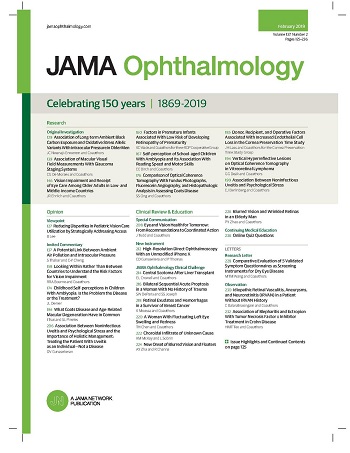预测国际空间站宇航员与太空飞行相关的神经眼综合征
IF 9.2
1区 医学
Q1 OPHTHALMOLOGY
引用次数: 0
摘要
航天飞行相关的神经-眼综合征(SANS)可能严重影响宇航员在长时间航天飞行(LDSF)中的表现。SANS的病理生理学仍然难以捉摸,没有发现SANS的预测因素;可靠的预测可以为SANS的个体易感性和人与人之间的变异性提供新的见解,并允许飞行治疗的发射前准备。目的对SANS飞行数据进行初步分析,以确定任务间SANS诊断和视盘水肿(ODE)严重程度的趋势。设计、环境和参与者在这项队列研究中,在飞行前、飞行中和飞行后完成了包括光学相干断层扫描(OCT)在内的眼部测试,然后对2007年至2024年在国际空间站(ISS)完成2次LDSF任务的美国国家航空航天局(NASA)宇航员的独特队列进行回顾性分析。数据分析时间为2024年4月至2025年4月。暴露失重,每次任务平均持续时间为6个月。主要结局和措施主要结局是SANS或非SANS诊断,由基于oct的ODE数据(2013年以后可用)确定每个任务。结果参加国际空间站LDSF的71名NASA宇航员中,有16名(22.5%)完成了2次长时间任务。4名宇航员是女性(20%),参与任务1和2的宇航员的平均年龄分别为46.1(4.0)和53.5(5.2)岁。对于这16个人,先前LDSF的SANS诊断或未诊断预测了随后LDSF的SANS诊断(敏感性85.7%;95% CI, 42%-100%;特异性100%;95% CI, 66%-100%;阳性预测值,100%,95% CI, 54%-100%;阴性预测值,90%;95% CI, 56%-100%; P < .001)。该组的一个子集(5名参与者,10只眼睛)在两个任务中都具有客观的ODE度量(即,在Bruch膜开口250µm内乳头周围视网膜总厚度的变化[ΔTRT])。对于单个眼睛,先前LDSF任务的ΔTRT高度预测随后LDSF的ΔTRT (r = 0.94; P & lt; .001)。结论和相关性在这项队列研究中,先前LDSF的SANS病例极有可能在随后的LDSF任务中被诊断为SANS,反之亦然,而单个眼睛的LDSF任务的SANS ODE严重程度显着相似。据我们所知,这些发现代表了对SANS的第一个也是唯一可靠的预测,允许在随后的LDSF任务中,甚至在发射之前,为个别宇航员量身定制精确的飞行治疗和预防策略。本文章由计算机程序翻译,如有差异,请以英文原文为准。
Predicting Spaceflight-Associated Neuro-Ocular Syndrome in International Space Station Astronauts
ImportanceSpaceflight-associated neuro-ocular syndrome (SANS) could severely impact astronaut performance during long-duration spaceflight (LDSF). The pathophysiology of SANS remains elusive, and no predictors of SANS have been discovered; reliable prediction may offer novel insight into individual susceptibility and interperson variability for SANS and permit prelaunch preparations for in-flight treatment.ObjectiveTo conduct a preliminary analysis of SANS flight data to determine mission-to-mission trends in SANS diagnosis and optic disc edema (ODE) severity.Design, Setting, and ParticipantsIn this cohort study, ocular testing, including optical coherence tomography (OCT), was completed preflight, during flight, and postflight, then retrospectively analyzed in a unique cohort of US National Aeronautics and Space Administration (NASA) astronauts who completed 2 LDSF missions onboard the International Space Station (ISS) from 2007 to 2024. Data were analyzed from April 2024 to April 2025.ExposureWeightlessness, with average durations of 6 months for each mission.Main Outcomes and MeasuresThe primary outcome was SANS or non-SANS diagnosis, determined by OCT-based ODE data (when available after 2013) for each mission.ResultsOf 71 NASA astronauts who have participated in ISS LDSF, 16 (22.5%) have completed 2 long-duration missions. Four astronauts (20%) were female, and mean ages of astronauts participating in missions 1 and 2 were 46.1 (4.0) and 53.5 (5.2) years, respectively. For these 16 individuals, a SANS diagnosis or nondiagnosis from prior LDSF predicted SANS diagnosis during subsequent LDSF (sensitivity, 85.7%; 95% CI, 42%-100%; specificity, 100%; 95% CI, 66%-100%; positive predictive value, 100%, 95% CI, 54%-100%; negative predictive value, 90%; 95% CI, 56%-100%; P &lt; .001). A subset of this group (5 participants, 10 eyes) possessed an objective metric of ODE across both missions (ie, change in peripapillary total retinal thickness within 250 µm of Bruch membrane opening [ΔTRT]). For individual eyes, ΔTRT of a prior LDSF mission was highly predictive of ΔTRT for a subsequent LDSF (r = 0.94; P &lt; .001).Conclusions and RelevanceIn this cohort study, SANS cases from previous LDSF were highly likely to be diagnosed with SANS in subsequent LDSF missions and vice versa, while SANS ODE severity appeared remarkably similar across LDSF missions for individual eyes. To our knowledge, these findings represent the first and only reliable forecast for SANS, permitting precise in-flight treatment and prevention strategies to be tailored for individual astronauts in subsequent LDSF missions, even before launch.
求助全文
通过发布文献求助,成功后即可免费获取论文全文。
去求助
来源期刊

JAMA ophthalmology
OPHTHALMOLOGY-
CiteScore
13.20
自引率
3.70%
发文量
340
期刊介绍:
JAMA Ophthalmology, with a rich history of continuous publication since 1869, stands as a distinguished international, peer-reviewed journal dedicated to ophthalmology and visual science. In 2019, the journal proudly commemorated 150 years of uninterrupted service to the field. As a member of the esteemed JAMA Network, a consortium renowned for its peer-reviewed general medical and specialty publications, JAMA Ophthalmology upholds the highest standards of excellence in disseminating cutting-edge research and insights. Join us in celebrating our legacy and advancing the frontiers of ophthalmology and visual science.
 求助内容:
求助内容: 应助结果提醒方式:
应助结果提醒方式:


